In this day and age, it’s likely that your brand has at least some social media presence. Your competitors do, too. That’s why it’s important to conduct a social media competitive analysis.
Social media is so important to help your business get the edge over your competition, but if you don’t know what they’re already doing on social media, there’s no way you can take what’s working and make it better for yourself.
In this article, we’re going to walk you through how to do a competitive analysis for social media, step-by-step, so you can better leverage the power of social media for your business.
What Is Competitive Analysis?
Competitive analysis is an analysis of your competition that helps you discover their strengths and weaknesses. The purpose of this analysis is to understand how your competition compares to you and gives you a benchmark against which you can find growth opportunities.
Plus, it helps you identify what’s performing (so you can do more of that) and what isn’t (so you can stop doing that).
To take that further, a social media competitive analysis helps you:
- Find out who your competitors are on social media
- Identify the social media platforms popular with your competitors (and target audience)
- Understand how your competitors are using the social media platforms they’re on
- Benchmark your own social media outcomes against your competition
- Identify threats and gaps in your social media strategy
Why a Social Media Competitive Analysis Is Important
Social media competitive analysis helps you hone in on what it is your competitors are doing on a platform and understand how your target audience interacts with them.
When you regularly monitor what your competitors are doing on social media, you’ll be in a better position to take what’s working and make it your own (but better).
Conducting a social media competitive analysis will let you keep tabs on your competitors and, more importantly, you’ll be able to understand the content that gets your target audience most excited.
Then, you can take what you’ve learned and create a social media strategy that blows your competitors out of the water.
Let’s take a closer look at the benefits of social media competitive analysis.
Benefits of a Social Media Competitive Analysis
We’ve already covered a bit about why it’s important to conduct a social media competitive analysis. In this section, we’re going to get into the specifics.
See Where You Rank
A social media competitive analysis will show you where your business ranks. It’s a great way to identify your competitors so you can then determine which competitors you want to focus on and outperform.
Pick Up on Useful Market Trends
A social media competitive analysis will also help you engage in social listening so you can identify and put to use any market trends that matter to your business.
This knowledge will help you keep your content new and engaging for your target audience while minimizing your risk for committing social media faux pas that will undoubtedly be documented.
Put Your Performance Into Context
All of the information and data you collect will help you track your performance against your competition, putting your performance into context.
This is invaluable.
When you have your finger on the pulse of how you and your competitors are performing, you’ll be able to understand what changes to your engagement or impressions really mean.
If your metrics are dropping, your first thought it likely that you’ve been shadowbanned or you’re doing something wrong (focusing on the wrong message, audience, or type of content). But, if your competitors are suffering the same decline in metrics, it’s more likely that the algorithm has changed and you need to adjust to that.
Make Smarter Strategic Decisions and Investments
A social media competitive analysis also gives you the insights you’ll need to make informed business decisions. This will lead to a better social media strategy and smarter investments.
Tailor Your Paid Strategy
Social media competitive analysis doesn’t end with finding out what your competitors are doing, but also where they’re using paid promotions.
Your goal should be to spend less money than your competitors and still get better results, but you’ll need to know what their paid social media strategy is before you can improve on it.
Measure and Finetune Your Strategy
Finally, a social media competitive analysis will help you measure your own social media strategy against that of your key competitors. This will give you a multitude of ways to understand how your own strategy is performing—and what you can do to improve it.
A competitive analysis is intended to be an ongoing process and when you use it as such, you’ll also be moving your business forward.
How to Conduct a Social Media Competitive Analysis
We’ve outlined seven steps to comprehensive social media competitive analysis that will work for your brand no matter your business size or industry.
Step 1. Identify Your Competitive Keywords
As with just about everything related to digital marketing and getting your brand found on the internet, we start with keyword research.
Create a list of the keywords your business is trying to rank for. You can use one of our favorite keyword research tools to do this.
Here’s how you can do this with Google Ads Keyword Planner for free.
Analyze Your Website
Start by logging in to your Google Ads account and going to the Keyword Planner. From there, click Discover new keywords > Start With a Website, then enter your own website in the website field and click Get Results:
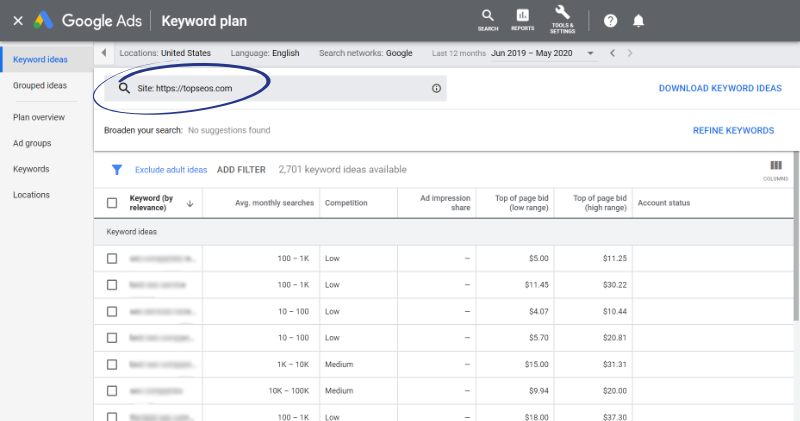
You’ll end up with a list of relevant keywords, average monthly searches, and level of competition (how hard those keywords are to rank for).
Find Related Keywords
If you already have a list of target keywords, you can use those keywords to get more ideas.
Again, start at the Keyword Planner, but this time we’re going to use Start With Keywords.
Just enter the keywords you want to use and click Get Results.
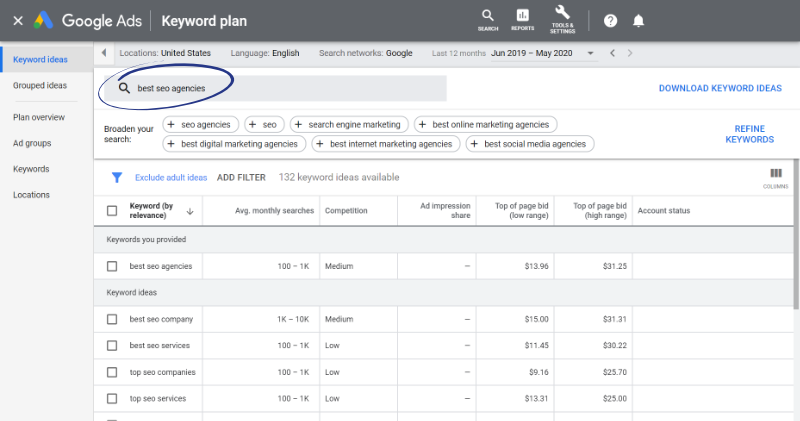
Once again, you’ll end up with a list of related keywords, search volume, and competition info.
Step 2. Find Out Who Ranks for Your Competitive Keywords
Once you have a decent list of keywords, narrow your focus to the 5–10 keywords that are most relevant to your business. A simple Google search will let you know who is ranking in the top 10 for those keywords. This will give you a good idea of who your competitors are.
Don’t forget to check out the ads at the top, bottom, and to the right of the organic results. This will tell you which of your competitors are paying for your competitive keywords. In addition to those ranking organically, you’ll want to check out the paid competitors’ social media activity, too.
From there, check out your competitors’ websites to find their social media details.
Step 3. Find Out Who Shows Up in Social Searches for Your Keywords
Next, you’ll want to search for your competitive keywords on each social media platform. It’s entirely possible that the businesses showing up on standard search engines will be entirely different from those ranking for those keywords on social media.
This is as simple as going to each social media platform and entering your competitive keywords in the search field:
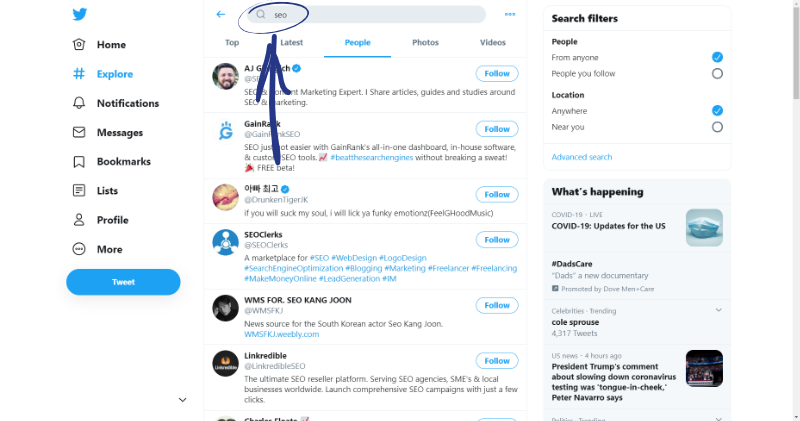
Make a note of all of your keywords and competitors as you go.
Step 4. Find Out Who Else Your Audience Follows
Now it’s time to take a look at who else your audience follows on social media.
Fortunately, most social media platforms have great analytics that can help you find this information easily. When you find a business with a target audience like yours, write them down as a competitor.
Here’s how to find information about what other businesses your target audience is following on Facebook and Twitter:
Facebook Audience Insights
Go to Facebook Audience Insights and use the tools on the left side of the page to define your target audience.
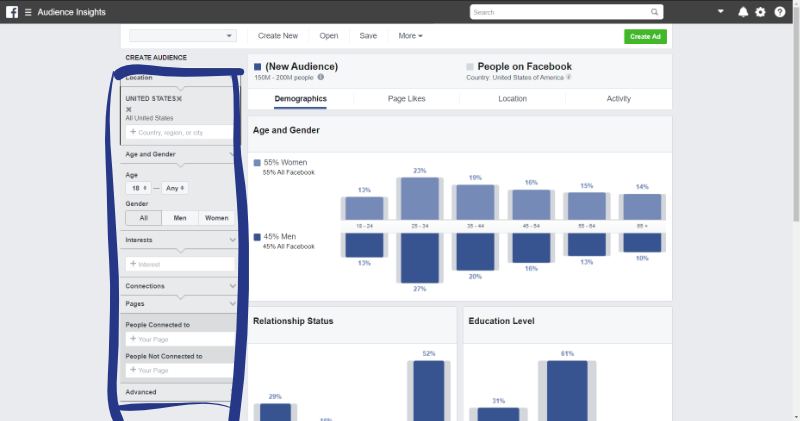
Then, click on the Page Likes tab.
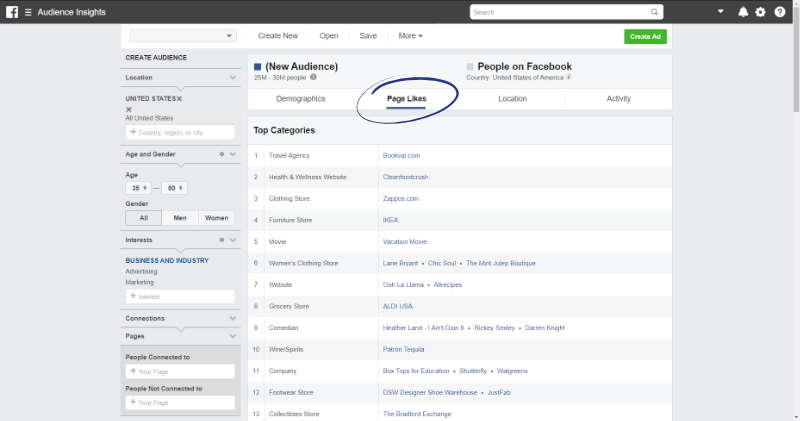
This will show you the pages liked by your target audience. If you find pages related to your industry, add them to your list of competitors.
Twitter Analytics
Go to Twitter Analytics and scroll down to your Top Followers. Then, visit each Top Follower’s profile to see the accounts they’re following.
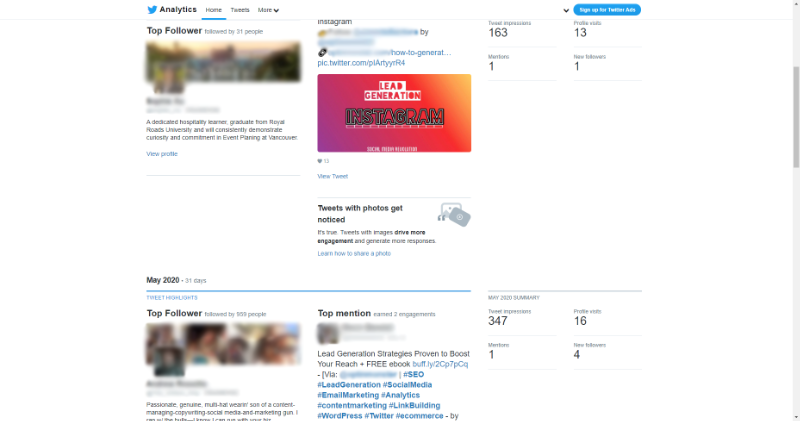
You can also click Tweets & Replies on their profiles to see who they interact with and how.
Step 5. Spy on Your Competitors
By now, you should have a pretty extensive list of competitors. We recommend narrowing your focus to your top 5–10 competitors. Once you have your list, you’re ready to find out what they’re doing on social media.
There’s no real trick to this. You just click through the social profiles and feeds of your competitors. There are, of course, some things you’ll want to keep an eye out for:
- What social media platforms do your competitors use?
- Who are their top followers?
- How many followers do they have and what’s their growth rate?
- How often do they post and what do they post?
- Do they use hashtags? Which ones? How many?
- What’s their engagement rate?
You can find a lot of this information just form snooping on your competitors’ profiles, but a faster, more efficient way to get this data is by using a social media competitive analysis tool or social listening tool.
Once you find this information about your competitors, you’ll want to document this same data for your own brand, too.
Step 6 Conduct a SWOT Analysis
Now it’s time to analyze all the data you’ve collected. While there are many ways you can do this, if you’re not using a social media competitive analysis tool, it will be easiest to use a standard SWOT analysis format.
If you’ve been in business for any amount of time, you’re probably familiar with SWOT. If not, here’s a quick breakdown:
SWOT stands for Strengths, Weaknesses, Opportunities, and Threats. It’s typically shown in a four-square grid format with each quadrant representing one of the letters S-W-O-T.
The first two categories (Strengths and Weaknesses) are internal to your business—what you are doing right (strengths) and where you can improve (weaknesses).
The last two categories (Opportunities and Threats) are external to your brand but that still impacts your brand.
Here’s what to put in each quadrant:
Strengths
Metrics where your performance outshines your competition.
Weaknesses
Metrics where your performance is falling short of your competition. This is important because you’ll want to work to improve these metrics.
Opportunities
Once you have your strengths and weaknesses outline, you’ll have a better idea of how you’re performing against your competitors overall. The next step is to think about your strengths and weaknesses and find areas where you want to improve.
Threats
Threats could be anything that threatens your position among your competitors. Keep an eye on growth numbers and those metrics that signify changes over time.
Step 7. Keep Monitoring Based on Latest Data
Once you’ve completed your social media competitive analysis, you’ll want to use that information to tweak your social media strategy.
But you can’t stop there.
A competitive analysis is an ongoing process that you’ll never truly be “done” with.
Social media platforms change over time, their popularity waxes and wanes, and the marketing landscape as a whole goes through changes, too. This means that you’ll need to conduct a social media competitive analysis quarterly, or at the very least, annually.
Each time you conduct a social media competitive analysis you’ll find that your competitors, the platforms they use, and what really inspires your target audience will change. This could cause big changes in your SWOT and, by extension, the changes you put in place to improve your social media marketing strategy.
Wrapping Up
Social media competitive analysis is mandatory if you want to build a successful social media marketing strategy and surge past your competitors.
We highly recommend that you use a social media competitive analysis tool or hire a digital marketing agency that specializes in social media to handle this important work for you. Here’s a list of the best social media marketing agencies that can help you out.




















